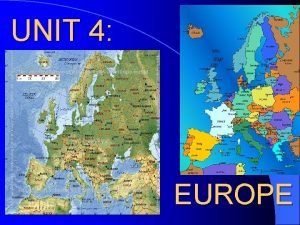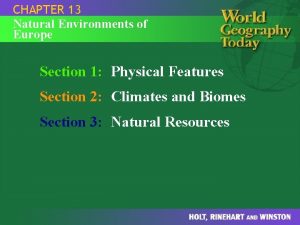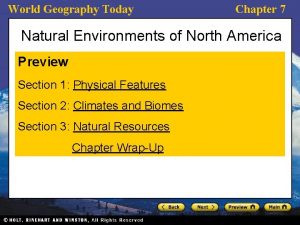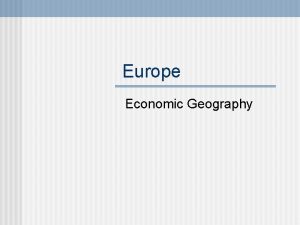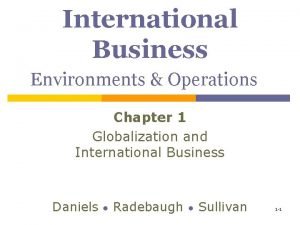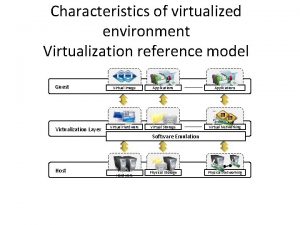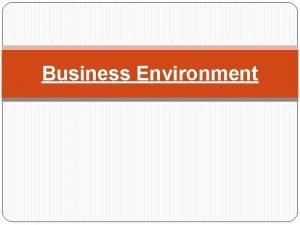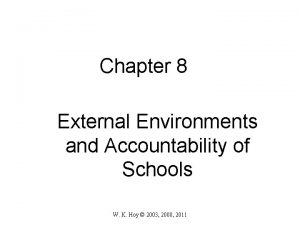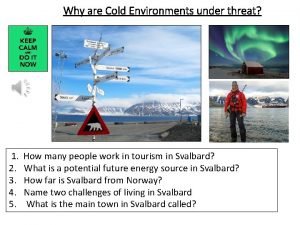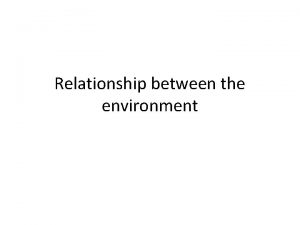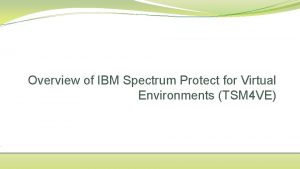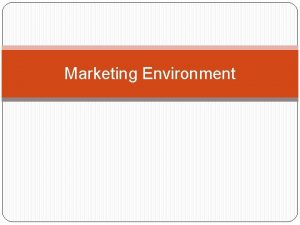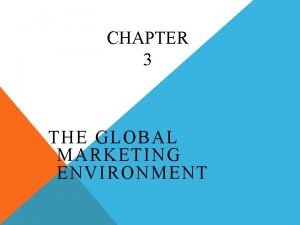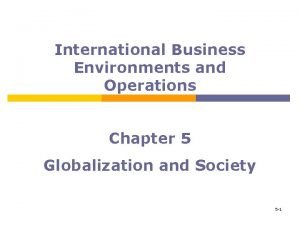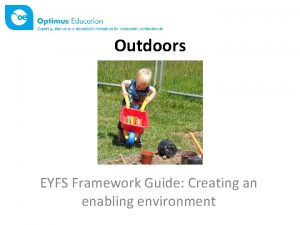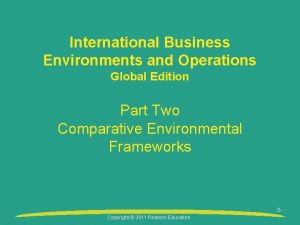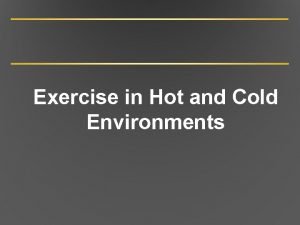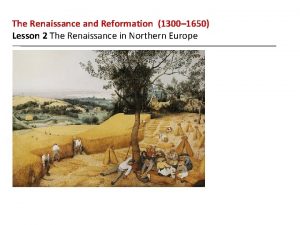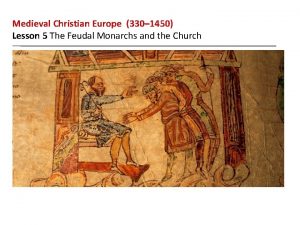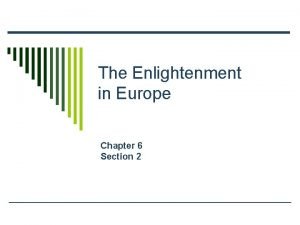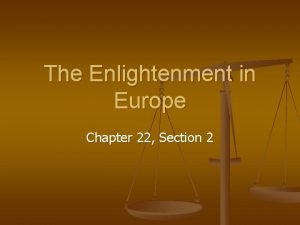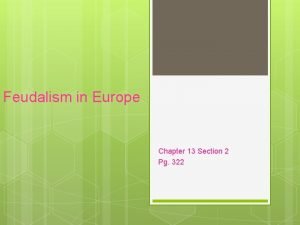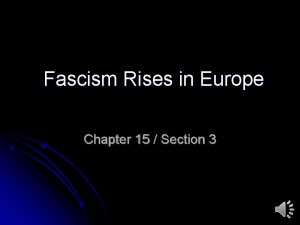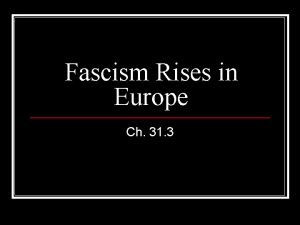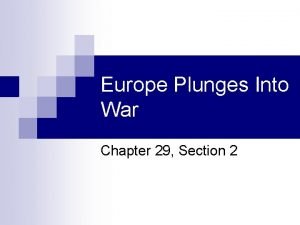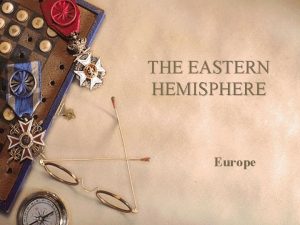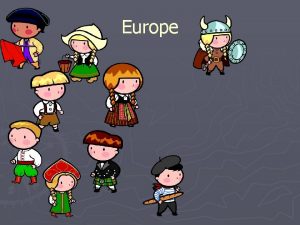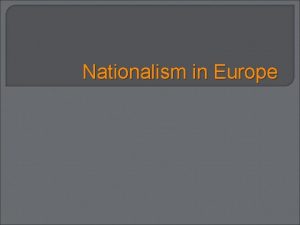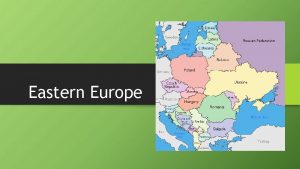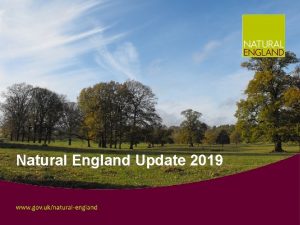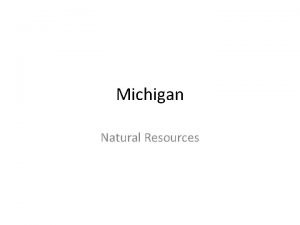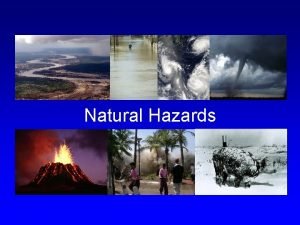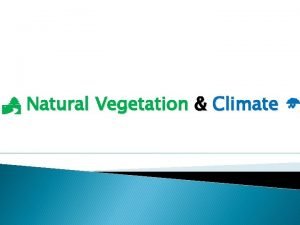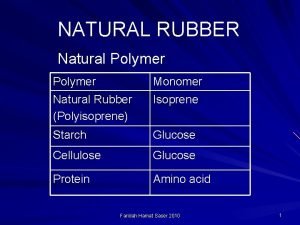UNIT 4 EUROPE Chapter 13 Natural Environments of












![Water in Europe-Thames River l pronounced: [timz] l England Water in Europe-Thames River l pronounced: [timz] l England](https://slidetodoc.com/presentation_image_h/2b50e52724443c141688eb48dcf8108f/image-13.jpg)
![Water in Europe-Seine River l pronounced: [la sɛn] l France Water in Europe-Seine River l pronounced: [la sɛn] l France](https://slidetodoc.com/presentation_image_h/2b50e52724443c141688eb48dcf8108f/image-14.jpg)


























- Slides: 40

UNIT 4: EUROPE

Chapter 13 – Natural Environments of Europe Section 1 – Physical Features (pgs 291 -294)

Landforms Europe stretches North to South: Artic Ocean Mediterranean Sea East to West: Atlantic Ocean Ural Mountains

Major Islands Great Britain, Ireland & Iceland

Major Peninsulas Scandinavian Italian Iberian, Balkan

4 Major Landform Regions l Northwest Highlands l Northern European Plain l Central Uplands l Alpine Mountain System

Northwest Highlands l rugged hills, low mountains l To the NORTH l Ireland, England, Scotland, Scandinavia, NW France, part of Iberian Peninsula l Glaciers & fjords carved landscapes during last ice age

Northern European Plain l To the SOUTH l Coastal plain with lots of rivers stretching from France to Ural Mountains = river towns & port cities like Paris & Berlin l Many rivers, short distances, smooth terrain = travel, trade, & migration l Densely or Sparsely Populated?

Central Uplands l Hills & small plateaus, fertile valleys l Stretches from France NE to S Germany l Eroded region = rounded hills & mountains l Known for coal & industry

l l l Alpine Mountain System Includes the Swiss Alps Stretches from France’s Mediterranean coast to the Balkan Peninsula Many peaks higher than 14, 000 feet Large snowfields and glaciers Also includes Carpathian Mountains in E. Europe & Pyrenees Mountains in France & Spain Tectonic process created this region and continues to cause earthquakes and volcanoes today

Objective: Describe Europe’s major landform regions. Europe’s Major Landform Regions Northwest Highlands Northern European Plain Central Uplands Alpine Mountain System hills & low mountains, created by glaciers, many lakes, thin soils Broad coastal plain, many rivers Hills & small plateaus, old & eroded, coal fields, fertile valleys High mountains, glaciers, tectonic activity (earthquakes)

Water in Europe is a peninsula of peninsulas (p. 295) § North Sea-important for trade & fishing (Baltic Sea freezes in winter) § North Atlantic Ocean. Explorers, Fishers, Merchants § Natural harbors along coast are located near navigable (deep enough & wide enough for shipping) rivers=good for trade by sea §
![Water in EuropeThames River l pronounced timz l England Water in Europe-Thames River l pronounced: [timz] l England](https://slidetodoc.com/presentation_image_h/2b50e52724443c141688eb48dcf8108f/image-13.jpg)
Water in Europe-Thames River l pronounced: [timz] l England
![Water in EuropeSeine River l pronounced la sɛn l France Water in Europe-Seine River l pronounced: [la sɛn] l France](https://slidetodoc.com/presentation_image_h/2b50e52724443c141688eb48dcf8108f/image-14.jpg)
Water in Europe-Seine River l pronounced: [la sɛn] l France

Water in Europe-Rhine River l Rises in the Swiss Alps, NW through Germany, enters the North Sea

Water in Europe-Danube River Begins in the uplands of S Germany, E through 9 countries in Central & Eastern Europe, empties into the Black Sea l The Danube River is 1, 771 miles long and the second longest river in Europe after the Volga. l

Water in Europe Major Challenge: POLLUTION entering ocean from rivers

Objective: Identify the major rivers and bodies of water found in Europe.

Chapter 13 – Natural Environments of Europe Section 2 – Climates and Biomes (pgs 296 -298)

Europe: 3 Major Climates l Marine West Coast l Humid Continental l Mediterranean

Marine West Coast Climate l throughout N & W Europe l Atlantic storms bring clouds & rain l Snow & frost in winter l Mild temperatures l Cloudy, drizzly days are common

Humid Continental Climate l 4 distinct seasons l Severe winters l Summer droughts hurt Hungary & Romania

Mediterranean Climate l Separated from other 2 climates by high mountains like the Alps l Most rain occurs during mild winter l Long, dry, sunny summers in S Europe

4 Minor Climates l Subartic (Norway, Sweden, Finland) l Tundra (Iceland & N Scandinavia) l Humid Subtropical (S, SE of Alps) l Semiarid (parts of Spain blocked from ocean by mountains)

Climates of Europe Major Climates Minor Climates Marine West Coast Subartic Mild temperatures, clouds & fog Found in Northern Norway Sweden & Finland Humid Continental Tundra Distinct seasons, cold winters, mild Northernmost Denmark, Norway & to cool summers Sweden (Scandinavia) & Iceland Mediterranean Humid Subtropical Mild & rainy winters, long summers South & southeast of the Alps Semiarid In Spain where mountains block the rainfall

Objective: Analyze how ocean currents affect Europe’s climates North Atlantic Drift l The North Atlantic Drift (which is an ocean current) warms the air above it. The current is then carried over Europe by winds. This creates moderate temperatures and precipitation in northern Europe. l warm, moist air creates mild temperatures & rain in NW Europe = good for farmers and sea movement (no ice in water)

Objective: Identify the biomes found in Europe. Plants & Animals: 4 Major Biomes Temperate Forest Mediterranean Boreal Scrub Forest Tundra • Covers most of • southern Europe • northern & • far northern Europe • ash, beech, maple, oak trees • badgers, deer, many birds • small trees, shrubs, central Europe • spruce, fir, pine • treeless trees • frozen ground most of the year • migratory birds, reindeer, foxes drought-resistant plants • wild boars, wild sheep

l. Temperate Forest (most of Europe has this) l. Mediterranean Scrub Forest l. Boreal Forest l. Tundra

Human activities harming plants & animals: §Hunting leads to animal extinction §Logging depletes forests and harms animal habitats §Pollution harms waterways and animals drinking water

Chapter 13 – Natural Environments of Europe Section 3 – Natural Resources (pgs 299 -301)

Natural Resources in Europe l Forests l Soils l Fisheries l Minerals l Energy

Natural Resources-Forests Problems: l Clearing & overgrazing l Air pollution & acid rain Solutions: l Reforestation & Forest Protection Programs for Sweden & Finland

Natural Resources-Soils More than half of Europe’s land area is used for farming l Some soils developed from loess (fine-grained windblown soil that is very fertile) l River valleys are major farming centers l Efficient methods & modern technology help Europe have crop yields among the highest in the world (Chemical fertilizers, crop rotation, machines to plant & harvest) l

Natural Resources-Fishing l Throughout history, an important part of Europe’s economy = fishing l Warm North Atlantic Drift mixes with cold polar waters (Iceland, Norway, Spain, Denmark) l Problems=Overfishing & coastal pollution

Objective: Locate Europe’s forest, soil, and fishery resources. Forest Soil Fisheries Sweden & Finland Loess in Northern European Plain & Alluvial soil in Southern Europe North Atlantic and Arctic Oceans and North Sea

Natural Resources-Minerals l To meet industry & energy needs, Europe heavily imports minerals l Lack oil, iron, & other metals (oil & gas come from Asia, Russia, Africa) l BUT, they have large deposits of coal (Germany-one of world’s largest, Britain, Poland) l Iron ore, uranium, lead, zinc, marble

The world’s largest deposits of amber are found along the shores of the Baltic Sea. Some date back to 60 million years ago. Preserved bodies of ancient insects have been found inside some deposits. The yellowish translucent amber is often made into jewelry.

Natural Resources-Energy l l l Europe’s main oil & natural gas lie beneath North Sea (especially helps Norway & Britain) Hydroelectricity is produced in Norway, Sweden, & Switzerland. France has ocean tidal power & solar power Iceland has geothermal energy Nuclear power (France, Belgium, Bulgaria, & Sweden)

Objective: Identify the energy and mineral resources of Europe.

Europe’s Main Energy Resources ENERGY SOURCE LOCATION Coal Germany, Britain, Poland Oil & Natural Gas North Sea region Hydroelectric Power Norway, Sweden, Switzerland France Ocean Tidal Power & Solar Power Nuclear Power France, Belgium, Bulgaria, Sweden
 Chapter 13 natural environments of europe
Chapter 13 natural environments of europe Chapter 13 natural environments of europe
Chapter 13 natural environments of europe World geography
World geography Natural resources of northern europe
Natural resources of northern europe Tiens cell rejuvenation capsules side effects
Tiens cell rejuvenation capsules side effects International business environments and operations
International business environments and operations Reference model of virtualization
Reference model of virtualization Objectives of business
Objectives of business Stable prediction across unknown environments
Stable prediction across unknown environments Psychologically informed environments
Psychologically informed environments Psychologically informed environments
Psychologically informed environments Creating supportive environments smoking
Creating supportive environments smoking High quality supportive environments
High quality supportive environments External environment and accountability of schools
External environment and accountability of schools Agent a chapter 2
Agent a chapter 2 Designing constructivist learning environments
Designing constructivist learning environments Economic activity
Economic activity Micro marketing environment
Micro marketing environment Ibm spectrum protect for virtual environments
Ibm spectrum protect for virtual environments Actors in marketing environment
Actors in marketing environment Information-intensive operating environments
Information-intensive operating environments Different environments
Different environments Marketing environments
Marketing environments International business chapter 5
International business chapter 5 Diverse learning environments survey
Diverse learning environments survey Enabling environments eyfs
Enabling environments eyfs International business environments and operations
International business environments and operations Exercise in hot and cold environments
Exercise in hot and cold environments International business environments and operations
International business environments and operations Diverse learning environments survey
Diverse learning environments survey Unit 10, unit 10 review tests, unit 10 general test
Unit 10, unit 10 review tests, unit 10 general test Natural hazards vs natural disasters
Natural hazards vs natural disasters Natural capital and natural income
Natural capital and natural income The reformation in europe lesson 2
The reformation in europe lesson 2 Which actions did french kings take to increase royal power
Which actions did french kings take to increase royal power Chapter 6 section 2
Chapter 6 section 2 The enlightenment in europe section 2
The enlightenment in europe section 2 Feudalism in europe chapter 13 section 2
Feudalism in europe chapter 13 section 2 Chapter 31 section 3 fascism rises in europe answer key
Chapter 31 section 3 fascism rises in europe answer key Chapter 31 section 3 fascism rises in europe
Chapter 31 section 3 fascism rises in europe Chapter 29 section 2 war consumes europe
Chapter 29 section 2 war consumes europe
